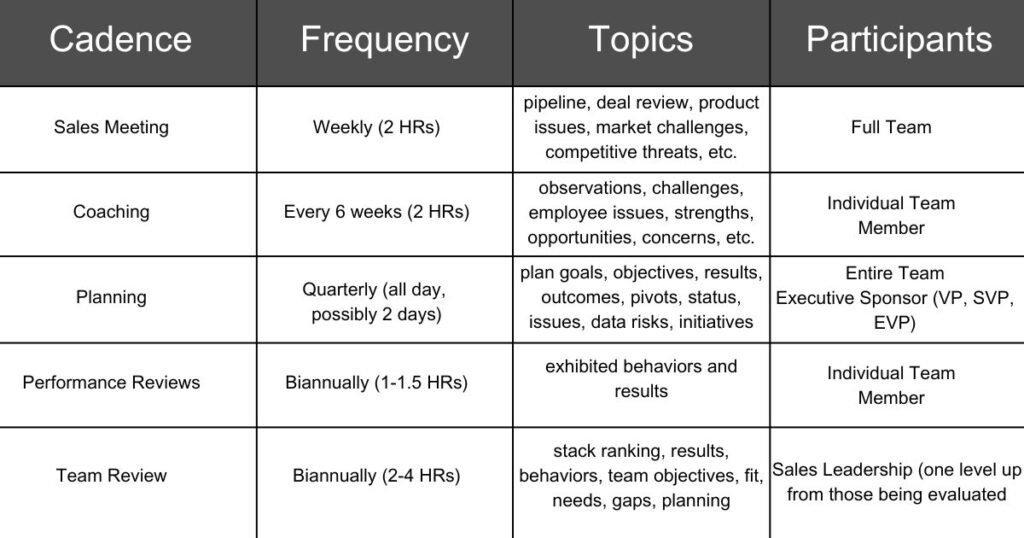Having a consistent coaching cadence for leading and engaging with your sales team is one of, if not, the most important piece of your day to day as a sales leader. A cadence is simply a rhythmic pattern or sequence you follow. For sales leaders, it provides a structured schedule for the activities involved in managing and coaching your team.
Too many sales managers and leaders bounce from one thing to the next without a method to the madness. Flying by the seat of your pants is not flexibility, it’s a recipe for dropping the ball and missing opportunities. Defining a coaching cadence ensures you cover all the key elements on a set schedule.
Leaders must hold regular pipeline reviews, provide individualized coaching, analyze performance, assess and address team dynamics and hiring needs, and track progress towards goals. Setting these meetings and time blocks ahead of time keeps everyone on the same page and embeds them into the processes.
Leading a high-performing sales teams requires leadership to juggle a lot. An intentional cadence creates a healthy rhythm to keep those tasks in the air at the same time.
Key Elements of a Coaching Cadence
Your cadence will likely have something unique to your team and organization. There are, however, some common elements across all cadences.
Day to day operations
Things like quota updates, deal reviews, pipeline breakdowns, outstanding receivables, new product roll-outs, personnel issues. The nitty-gritty. The things every member of the leadership team should have visibility on. Create a cadence for recognizing and dealing with these operational details on a daily basis.
Coaching
Hands down, one of the most important pieces for developing and retaining top talent. Make coaching a real priority in your cadences. What you don’t want is an “oh shit, I forgot about Jill” moment. Reps need to know that they have a dedicated time booked on your calendar for help and feedback.
Planning/Goal Setting
Every company, team, individual has, or should have, some sort of quarterly, monthly, weekly objectives they’re striving to hit. Sales is usually pretty good at this considering most reps have a quota laid out in their comp package. This should extend beyond that though. As a coach, what increase in close rates, average deal size, etc. are you hoping to achieve? What steps are you taking on a daily, weekly, monthly basis to assess the changes you’ve implemented to measure their success? Goals don’t mean much without checking back in on them regularly. Use you cadence to measure progress and hold yourself and your team accountable.
Performance reviews
Separate from coaching, performance reviews are your opportunity to give formal evaluation and feedback. This is where you address the goals each rep had and what steps they were taking to achieve these goals. Are they improving? Do they need training or reflection on a certain area?
Team Assessment
You’ve assembled you team over the course of months or maybe even years. Dynamics shift. Take the time to analyze if your team is structured properly to the market. Do you have the right people in the right roles? Are the roles filled? Where are the gaps?
Again, there’s no one size fits all template for these things. The perfect cadence depends on your goals, team size, market dynamics, and the level of chaos you’re currently dealing with. That said, my advice? Start with the basics I just mentioned: pipeline reviews, coaching, planning, performance reviews, and team assessments. That’s your baseline.
Sales Coaching Cadence Template
To start, this is what I suggest to mid-sized teams.

Weekly: Sales meeting: pipeline, deal review, product issues, market challenges, threats
Every 6 weeks: 1:1 coaching – observations, challenges, employee issues, strengths, opportunities, concerns
Quarterly: Planning – plan goals, objectives, outcomes, results, pivots, challenges, risks, approaches, lessons learned.
Biannually: Performance reviews – exhibited behaviors and results
Biannually: Team review – stack ranking, results, behaviors, tea objectives, fit, future needs, gaps, planning
The exact mix and timing will depend on your team’s needs. What is important though is that once you find the cadence that works, commit to it. Send out the recurring invited and block off everyone’s calendars to make sure this happens.





0 Comments